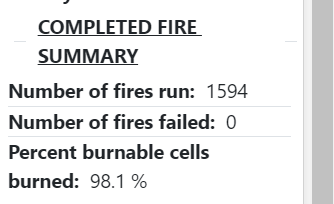Ignition for Landscape Burn Probability (LBP)
The LBP model simulates thousands of randomly located ignitions that are allowed to spread into fires for the specified Burn Period Length. Only ignitions located on burnable fuels are kept and recorded. If an ignition is located on a non-burnable fuel model it is removed from the simulation and is not recorded. During this process:
- Each random ignition is placed on an unburned version of the landscape.
- Prior ignitions do not alter fuels.
- Weather conditions are held constant for the duration of the burn period.
- The same burn period is used for every fire.
You can choose to either use random ignitions, or to use random ignitions from a completed Landscape Burn Probability run, if one exists for the given landscape extent.

Using Random Ignitions
When the Use Random Ignitions option is selected, the number of random ignitions, and therefore fires simulated, is determined by IFTDSS and is based upon:
- Landscape size
- Number of burnable pixels
- Dead 1-hr and 10-hr fuel moisture
- Live herbaceous and woody fuel moisture
- Time to simulate a single fire
For the best results, the percentage of burnable cells burned in the simulation should be very high. Once this has been achieved, increasing the number of ignitions does not significantly change the outputs but does increase processing time. Setting the correct number of ignitions to achieve this often takes a lot of trial and error. To streamline the above process, IFTDSS determines the number of ignitions to be used for each run. A minimum 1,000 fires is used. In the case that 1,000 fires is not sufficient, IFTDSS keeps adding ignitions until at least 98% of burnable pixels (cells) on the landscape burn or there is no significant change to the percentage burned even if the 98% target is not hit.
The goal of 98% of burnable pixels burned may not be achieved for a few reasons. One scenario is a landscape with many small islands of burnable fuels surrounded by non-burnable fuels. Here the chance of random ignitions landing and fire spreading in all of them is minimal, and the computing time to do this is excessive. Another scenario is where the user has set relatively moist input values (e.g., high initial fuel moistures or very slow wind speeds) where fire spread is minimal. the number of ignitions to achieve 98% of burnable fuels will take longer than is possible to model with IFTDSS.
Use Ignitions From a Completed Run
The Use Ignitions From a Completed Run option allows the ignitions locations to be held constant between Landscape Burn Probability runs completed within the same “landscape family.” A landscape family includes the originating landscape and all edited (alternative) landscapes associated with the originating landscape. This is important for comparisons such as Compare Weather, where the same ignition must be used for all the model outputs being compared.
Unlike Landscape Fire Behavior which simulates fire on every pixel regardless of its neighbors, Landscape Burn Probably simulates fire spreading into nearby pixels from random ignition points. This approach means that fire spread and intensity in one pixel is affected by fire behavior in neighboring pixels. Because these pixels are affected by thousands of random ignitions in a LBP model run, re-using ignitions is critical for completing true comparisons between outputs to determine impacts of changes to fuels (such as those represented by landscape edits or treatment alternatives) or model inputs (e.g. wind direction or spotting probability).
Important! See the LBP Model Run Considerations topic for additional guidance, specifically the section titled "Using Ignitions from a Completed run for LBP Refinement or Comparison."
Viewing Number of Fires in IFTDSS when Random Ignitions are Used
You can check the status of a run as it progresses. From My Modeling Playground, hover over or click your model run name and look at the bottom of the Right Hand Panel. Refreshing the status column updates the values allowing you to track the progress of the model. Once the run is completed the header title to this section changes from “In Progress Fire Summary” to “Completed Fire Summary.”

Once a run is completed the final number of fires run, number of fires failed, and percentage of burnable cells burned are available in the right hand panel of both My Modeling Playground and My Workspace, as well as the View Inputs pop-up in My Modeling Playground (shown below). A fire can fail if the ignition lands on burnable fuels, but does not get large enough to burn onto an adjacent pixel.
